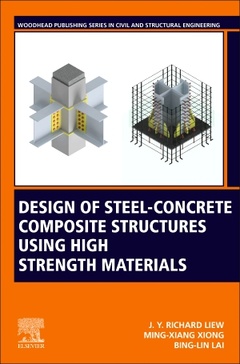Design of Steel-Concrete Composite Structures Using High-Strength Materials Woodhead Publishing Series in Civil and Structural Engineering Series
Auteurs : Richard Liew J.Y., Xiong Ming-Xiang, Lai Bing-Lin

High-strength materials offer alternatives to frequently used materials for high-rise construction. A material of higher strength means a smaller member size is required to resist the design load. However, high-strength concrete is brittle, and high-strength thin steel plates are prone to local buckling. A solution to overcome such problems is to adopt a steel-concrete composite design in which concrete provides lateral restraint to steel plates against local buckling, and steel plates provide confinement to high-strength concrete.
Design of Steel-Concrete Composite Structures Using High Strength Materials provides guidance on the design of composite steel-concrete structures using combined high-strength concretes and steels. The book includes a database of over 2,500 test results on composite columns to evaluate design methods, and presents calculations to determine critical parameters affecting the strength and ductility of high-strength composite columns. Finally, the book proposes design methods for axial-moment interaction curves in composite columns. This allows a unified approach to the design of columns with normal- and high-strength steel concrete materials.
This book offers civil engineers, structural engineers, and researchers studying the mechanical performance of composite structures in the use of high-strength materials to design and construct advanced tall buildings.
1. Introduction 2. Materials 3. Test Database 4. Design of Steel-Concrete Composite Columns Considering High Strength Materials 5. Behaviour and Analysis of High Strength Composite Columns 6. Fire Resistance Design 7. Special Considerations for High Strength Materials 8. Joints in Composite Construction
Appendix A. Design Flowchart B. Worked Examples and Comparison Studies C. Design Spreadsheets for Composite Columns
Ming-Xiang Xiong is an associate professor in the School of Civil Engineering, Guangzhou University, Guangdong, China. He received his doctorate from the National University of Singapore. He has been involved in composite structure research and design for more than 15 years, and his extensive research focuses on steel-concrete composite structures subjected to static and extreme environmental load. He has authored and co-authored more than 20 journal papers and the Singapore code on composite structures known as BC4:2015.
Bing-Lin Lai is an assistant professor in the School of Civil Engineering, Southeast University, Nanjing, China. He received his doctorate from the National University of Singapore. His research mainly focuses on the behaviour and design of high-performance steel-concrete composite structures and prefabricated prefinished volumetric construction. He has authored and co-authored over 10 journal papers.
- Presents the design and construction of composite structures using high-strength concrete and high-strength steel, complementing and extending Eurocode 4 standards
- Addresses a gap in design codes in the USA, China, Europe and Japan to cover composite structures using high-strength concrete and steel in a comprehensive way
- Gives insight into the design of concrete-filled steel tubes and concrete-encased steel members
- Suggests a unified approach to designing columns with normal- and high-strength steel and concrete
Date de parution : 08-2021
Ouvrage de 254 p.
15.2x22.8 cm
Thèmes de Design of Steel-Concrete Composite Structures Using... :
Mots-clés :
High strength concrete; High strength steel; Concrete filled steel tubular columns; Concrete encased steel columns; Design guide; Concrete; Structural steel; Reinforcing steel; Shear connector; Bolts; Concrete filled steel tubular members; Concrete encased steel members; Composite columns; High strength composite columns; Concrete confinement effect; Fiber section analysis; Fire resistance; Ultra-high performance concrete; Column splice joint; Steel beam to composite column joint; Rc beam to composite column joint; and column base joint



